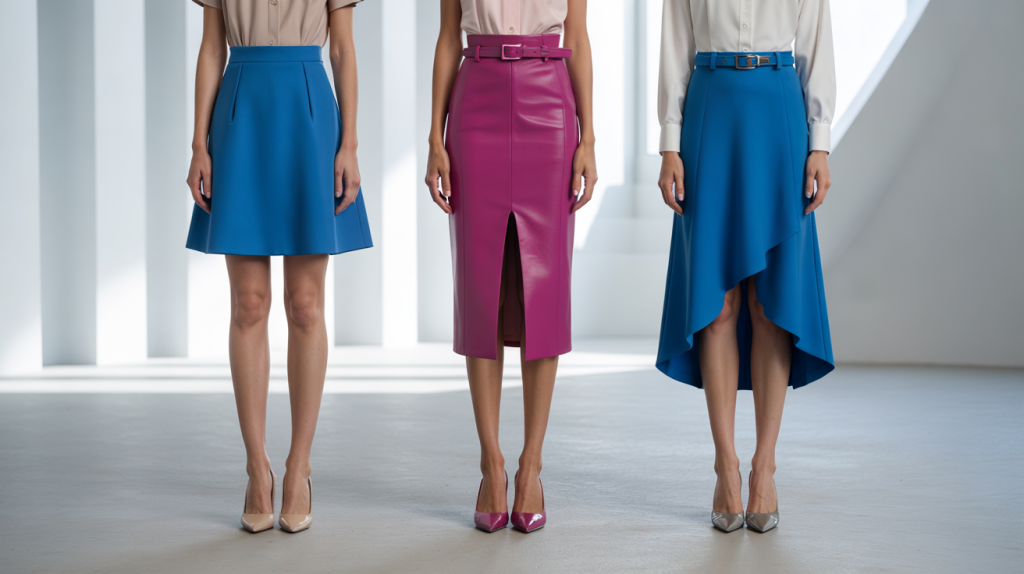Two inches can change everything. Pick the right skirt cut and the leg line looks longer on the spot, no heels needed, no filters either.
Here is the short answer many search for: a high waist, a clean A-line mini, a pencil skirt with a front slit, or an asymmetrical hem create vertical momentum that lengthens the legs. Tonal styling and pointed shoes push the effect further. The rest explains why this works and how to choose the exact length for a body, not the other way around.
High waist and the rule of thirds: how proportion makes legs read longer
Proportion beats trend. Style experts lean on the rule of thirds, a simple 1 to 2 balance that places the waist near the upper third so the bottom reads as two thirds of the look. The idea surfaced in print in 1797 with John Thomas Smith and still guides visual composition today (John Thomas Smith, 1797).
If a skirt sits at the natural waist or slightly above, the eye reads more leg, less torso. Many also like the golden ratio split, around 61.8 percent for the lower section and 38.2 percent for the top. It is a classic harmony principle discussed in design literature and popularized for general audiences in 2002 by Mario Livio (Mario Livio, 2002). On a dressed body, that translates into a higher waist seam and a hem that lands where the calf narrows.
Length and hem shape: mini, midi with slit, and the power of diagonals
Length matters, but placement matters more. A mini that skims mid thigh often measures around 38 to 45 cm. It opens the leg line and raises the focal point. On many, a clean A-line mini avoids clinging and looks balanced with flats or low heels.
A midi that ends at the slimmest part of the calf keeps the column effect. Add a front or side slit and movement creates a vertical stripe. Pencil skirts with a front slit lengthen because the break sits in the center line, not at the sides. Asymmetrical hems work the same way. A diagonal hem pulls the gaze upward in a smooth climb, which visually stretches the leg.
Patterns, color and shoes: optical tricks with research behind them
Optics help. Vertical elements act like rails for the eye. Designers have long referenced the Helmholtz observation that certain stripe orientations alter perceived height and width, published in 1867 in his work on physiological optics (Hermann von Helmholtz, 1867). Later experiments tested clothing illusions on bodies. Research in 2011 explored stripe direction and perceived size on dressed figures and showed that perception shifts with pattern and context (Peter Thompson and Maria Mikellidou, i Perception, 2011).
In practice, a column of color from waist to toe reduces visual breaks. Nude shoes close to skin tone erase the ankle boundary. Pointed toes extend the foot line. A narrow belt in the exact skirt color keeps the waist high without slicing the body in half. It sounds tiny. It is decisive.
The easy shopping filter: five skirt cuts that reliably elongate legs
When browsing or trying on, this simple checklist speeds decisions and avoids returns. It has worked across heights and body shapes because it plays with proportion, not size. And yes, it is definitly quick.
- High waist A-line mini that finishes mid thigh, with a smooth waistband and no heavy pockets
- Pencil skirt with a center or slightly off center front slit that hits just above the knee cap
- Bias cut midi that lands at the narrowest point of the calf, ideally with a subtle front slit
- Asymmetrical hem skirt that rises at the front and dips at the back for a gentle diagonal
- Column maxi with a high side slit plus shoes in a matching tone to keep one vertical color block
Fit checks help. The waist should close at or above the natural waist. If the hem chops the calf at its widest zone, the leg can look shorter. Shift the hem a few centimeters and the effect flips. A tailor can lift a waist seam or adjust a hem with little cost compared with a full remake.
Numbers keep this method honest. The one third to two thirds split dates to 1797. The golden ratio sits at 61.8 percent on the long section. Optical literature from 1867 and clothing perception work in 2011 explain why verticals, diagonals and strategic contrast guide the eye. Bring those cues into a skirt and the legs read longer before adding a single extra centimeter in shoe height.
